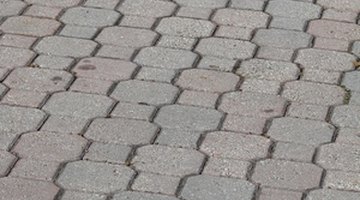How to Remove Mold on Brick Pavers
Brick pavers can make an attractive addition to a home, and their clay-based construction is environmentally friendly. Like other structures in landscaping, pavers may become subject to the effects of mold and other fungi. Mold may appear as a black, brown or dark green slime, accompanied by a strong musty odor.

Things You Will Need
- Blow dryer
- Broom
- Dust pan
- Trash can
- Hose
- Spray bottle
- White vinegar
If mold overtakes your brick pavers, you can eliminate the problem using the right mold-killing solutions.
-
Clear any obstacles that cover any part of your brick pavers. For example, if you have pavers lining your driveway, remove any cars, boxes, tools, plants or other objects. This will allow you to find any hidden mold while exposing more of the surface to sunlight, nature's mold killer.
-
Dry the surface mold using heat. If you try wiping away mold in its active state, you will simply spread it around while compromising your own health. If you dry it before removing it, it will become dormant and therefore easier to remove. Areas now exposed to sunlight should dry on their own. For mold outside of the sun's path, use a blow dryer or space heater.
-
Wipe the dried mold spores from your bricks using a broom. In order to prevent the mold from becoming active nearby at a later time, brush it directly into a dustpan or trash can and dispose of the spores.
-
Hose down your brick pavers. Although excess moisture is typically not recommended for mold removal, bricks will dry faster than other, more absorbent surfaces. Apply just enough water to dampen all mold-affected areas.
-
Pour 5 percent white vinegar into a spray bottle (undiluted). Spray all bricks affected by mold. The acetic content will kill the mold on contact, as well as other fungi, weeds and algae. Furthermore, the water on the bricks will allow the vinegar to effectively kill mold without disappearing beneath the surface.
References
Photo Credits
- pavers image by Pix by Marti from Fotolia.com
- pavers image by Pix by Marti from Fotolia.com
More Articles



